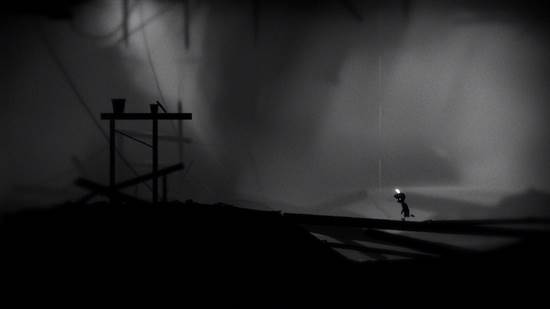Also On: PSN, PC, Xbox 360
Publisher: Playdead
Developer: Playdead
Medium: Digital
Players: 1
Online: No
ESRB: T
I might lose my gamer card for admitting this, but prior to Limbo’s release on the PS Vita, I’d never played it. I don’t have an Xbox, my PC is only a few steps above a hamster on a wheel, and even though I’d downloaded the PS3 version when it showed up on PlayStation Plus, it had been sitting in backlog, er, limbo ever since I got it. All I knew about it was that it had a neat black and white art style, and that it was one of the most widely-acclaimed games of the last few years.
As such, I can’t really say whether the Vita version of the game fully captures every nuance of its console counterpart. Nor can I tell you if anything was lost in the transition from big screen to small. I can, however, say this: Limbo on the Vita looks incredible, and all the high praise it earned on PC/Xbox 360/PS3 is just as deserved here.
Oh, and also: it is freaking hard. You will die in this game, and you will die often, and there’s no way to avoid that basic fact.
It’s a deceptive level of difficulty, though. Unlike, say, Life of Pixel, where you need to grind forward until you’ve memorize every step and jump along the way, Limbo generally moves along at a more leisurely pace. Apart from a few places where speed is of the essence, you’re generally able to move along as quickly or as slowly as you’d like. On top of that, there aren’t many places where it’s not immediately obvious what you need to do next. Just make that little jump, drag the box from here to there, and — voila! — you’re done.
The challenge, of course, is in actually doing that stuff. What you don’t see at first are the traps partially hidden in the grass, or the spikes jutting out at the bottom of that hill, or the giant spiders ready to impale you on their monstrously sharp legs, or the evil children waiting to shot you with arrows, or the deep, dark ponds, or…you get the idea. There are innumerable ways to die in Limbo, and you will most likely experience each and every one of them repeatedly before you finish the game.
To some extent, of course, that’s part of the fun, and this is one of those games where you feel a sense of accomplishment with every chapter you finish. That said, however, I have to admit that all the deaths — and the game as a whole, for that matter — kind of disturbed me. You’d think that after a while, they’d become routine, but no, I felt squeamish every time my onscreen character sank lifelessly to the bottom of a pond, every time a trap snapped shut and beheaded me, every time spider legs sliced through my body and lifted me into the air.
A lot of this can be attributed to the game’s general look and feel. Limbo has become somewhat famous for its stark black and white colour scheme, and that shows up perfectly on the Vita’s OLED screen. In addition to that, though, there’s the game’s sounds — or lack thereof. For the most part, the only noise is those of your movements, which combines with the graphics to create a claustrophobically tense atmosphere.
Ordinarily, this is where I’d encourage you to go download Limbo immediately. But it’s not as simple as that — after all, it’s already available on three other platforms, and has been for some time. So I’ll say this: if you haven’t played it, then already grab it immediately, since it’s easily one of the Top 10 Vita games, and it has a pretty strong argument as one of the Top 5. (The same goes for people who already have the game for PS3, since it’s a Cross-Buy title). And if you have played it? Well, it can’t hurt to play it again, and to remind yourself of why it’s such an outstanding title.




